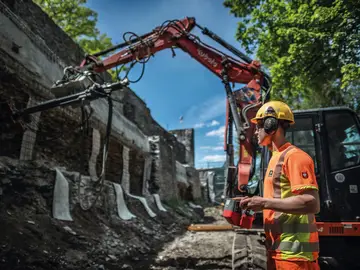Sensitive work: Rehabilitation of a historic castle ruin
Elsterberg, Germany – Surrounded by the White Elster river at the northern border of the historical center of Elsterberg, there is a historical monument with many years of history: the Elsterberg castle ruins. With an area of 1.5 hectares, this is not only the largest estate of its kind in Saxony, but also a popular tourist destination. To make sure it stays that way for a long time, the 800-year-old ruins were sustainably secured and rehabilitated by SPESA Spezialbau und Sanierung GmbH.
Since July 2019, the team under Spesa Operations Manager Gerald Jech has been working to restore the historical natural stone walls of the castle ruins. From one construction phase to the next, the specialists are proceeding with their work and stabilizing the existing masonry. Specifically, the masonry structures are needled using stainless steel rods, stabilizing anchors are installed and existing cavities are filled with suitable injection material. “Depending on the structural condition of the individual sections of masonry, we sometime decide how to proceed directly on site, as historical structures generally harbor surprises and require flexibility”, emphasizes Foreman Lutz Mescheder from SPESA Spezialbau und Sanierung GmbH. For example, where the masonry structure is too heavily weathered, it is completely stripped down. Then it is reconstructed and grouted by machine. But the grouting of the wall is not all that needs to be done: In order to fulfil the requirements of a protected monument site, the historical appearance of the natural stone walls needs to be restored as closely as possible. For this purpose, a layer of replaceable plaster is applied by machine using the dry spraying method to recreate the original condition. “Plastering itself is a real science that requires a lot of sensitivity and flawless execution,” explains Gerald Jech. In addition, close coordination was required with the Saxony office for historical monuments in Dresden, the design firm Dipl.-Ing. Thomas Schafferhans from Mylau, the Elsterberg City Administration as owner and the Vogtländischer Heimatverein association as volunteer preservationists – after all, the castle ruins come from the 13th century.
Apart from the strict historical monument requirements, the transport of all materials and equipment was also a challenge for the team: Due to very narrow paths and castle gates, only the smallest equipment was able to access the castle grounds. In places, the required elements even had to be brought on foot to the site 300 m away – a strenuous task. The workplace itself is always a challenge and should be approached with the utmost caution: “Cramped and cumbersome – these are circumstances you have to live with when you’re dealing with historical structures”, explains Lutz Mescheder.
The last planned construction phase began in February 2022. During this stage, the masonry around tower III, known as the “Hunger Tower”, are being secured and restored. With that, Gerald Jech and his team have managed a total of six construction stages over the last three years. The construction specialists are already well-versed thanks to their many years of collaboration, and their work on the castle ruins has become a favorite project by now. The completion of the construction work is planned for summer 2022 – after that, the historical landmark will adorn the city of Elsterberg for many decades to come with its new splendor, bringing delight to tourists.
Downloads
Your Contact

Specialized press Resources, Redevelopment, Environment
